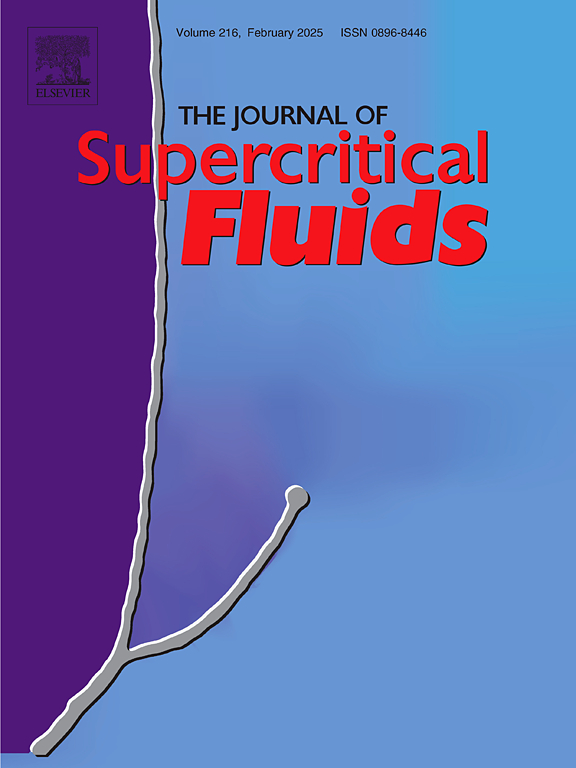Extraction of β-carotene and lipids from wet biomass of the oleaginous yeast Rhodosporidium toruloides with supercritical CO2
IF 3.4
3区 工程技术
Q2 CHEMISTRY, PHYSICAL
引用次数: 0
Abstract
The present study investigated supercritical CO2 extraction (SCE) of β-carotene and lipids from wet biomass of the oleaginous yeast Rhodosporidium toruloides to assess its potential as a green and energy-effective extraction process. The influence of the water content of the biomass on the extraction kinetics was investigated by performing SCE with biomass with different water contents (80.3 wt%, 40 wt%, and 3 wt%). The CO2 flowrate was set to 0.240 g s−1. Despite an initial delay in the extraction process, the extraction yields from wet and dried biomass after 195 min (50 °C and 250 bar) showed no significant difference, confirming that an energy-intensive drying step before extraction can be avoided. The effects of temperature (40 °C - 70 °C) and pressure (200 bar - 400 bar) on extraction kinetics were systematically studied. Ethanol as a co-solvent significantly improved extraction efficiency, increasing β-carotene yield (up to 77 %) and lipid yield (up to 49 %). Yeast intracellular lipids were proven to act as an effective natural co-solvent for β-carotene extraction, as evidenced by the significant improvement in β-carotene recovery by 63 % when 10 wt% sunflower oil was added to the wet biomass as a co-solvent. The fatty acid methyl esters (FAME) analyses showed that the extraction conditions did not influence the FAME composition. The obtained extracts exhibited notable antioxidant activity, with an IC50 of approximately 2 mg mL−1, highlighting the potential of the oleaginous yeast Rhodosporidium toruloides as a valuable source for applications in functional foods and pharmaceutical products.
超临界CO2从产油酵母红孢子虫湿生物质中提取β-胡萝卜素和脂质
本研究研究了超临界CO2萃取法(SCE)从产油酵母红孢子虫(Rhodosporidium toruloides)的湿生物质中提取β-胡萝卜素和脂质,以评估其作为一种绿色节能的萃取工艺的潜力。通过对不同含水量(80.3 wt%、40 wt%和3 wt%)的生物质进行SCE,研究了生物质含水量对萃取动力学的影响。CO2流量设置为0.240 g s−1。尽管在提取过程中存在初始延迟,但在195 min(50°C和250 bar)后,湿法和干法生物质的提取率没有显着差异,这证实了提取前的能量密集型干燥步骤是可以避免的。系统研究了温度(40℃~ 70℃)和压力(200 bar ~ 400 bar)对萃取动力学的影响。乙醇作为助溶剂显著提高了提取效率,提高了β-胡萝卜素得率(高达77 %)和脂质得率(高达49 %)。酵母细胞内脂质被证明是一种有效的天然助溶剂,用于β-胡萝卜素的提取,当10 wt%的葵花籽油作为助溶剂添加到湿生物质中,β-胡萝卜素的回收率显著提高63 %。脂肪酸甲酯(FAME)分析表明,提取条件对脂肪酸甲酯的组成没有影响。所获得的提取物具有显著的抗氧化活性,IC50约为2 mg mL−1,突出了产油酵母toruloides作为功能食品和制药产品应用的宝贵来源的潜力。
本文章由计算机程序翻译,如有差异,请以英文原文为准。
求助全文
约1分钟内获得全文
求助全文
来源期刊

Journal of Supercritical Fluids
工程技术-工程:化工
CiteScore
7.60
自引率
10.30%
发文量
236
审稿时长
56 days
期刊介绍:
The Journal of Supercritical Fluids is an international journal devoted to the fundamental and applied aspects of supercritical fluids and processes. Its aim is to provide a focused platform for academic and industrial researchers to report their findings and to have ready access to the advances in this rapidly growing field. Its coverage is multidisciplinary and includes both basic and applied topics.
Thermodynamics and phase equilibria, reaction kinetics and rate processes, thermal and transport properties, and all topics related to processing such as separations (extraction, fractionation, purification, chromatography) nucleation and impregnation are within the scope. Accounts of specific engineering applications such as those encountered in food, fuel, natural products, minerals, pharmaceuticals and polymer industries are included. Topics related to high pressure equipment design, analytical techniques, sensors, and process control methodologies are also within the scope of the journal.
 求助内容:
求助内容: 应助结果提醒方式:
应助结果提醒方式:


